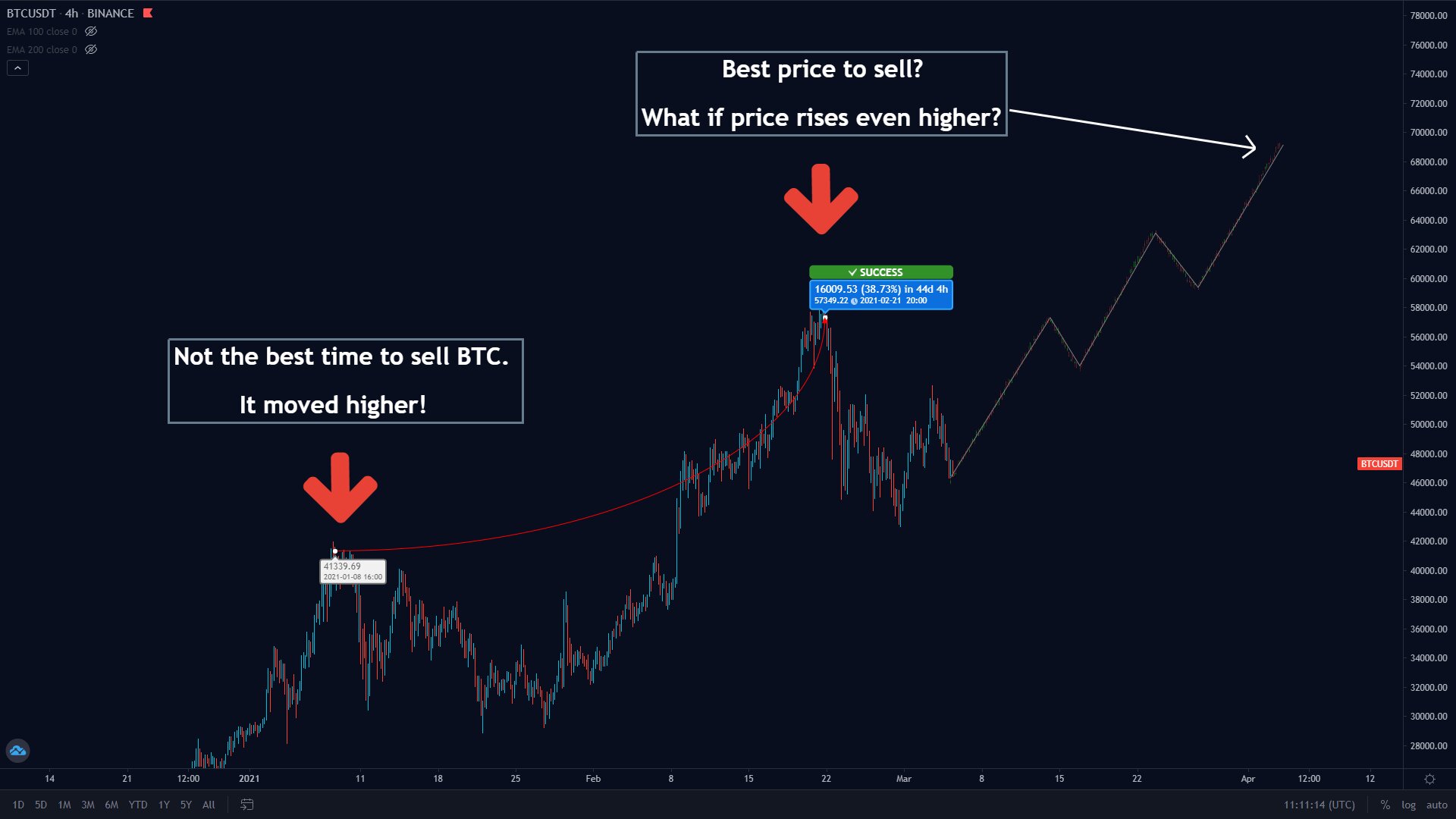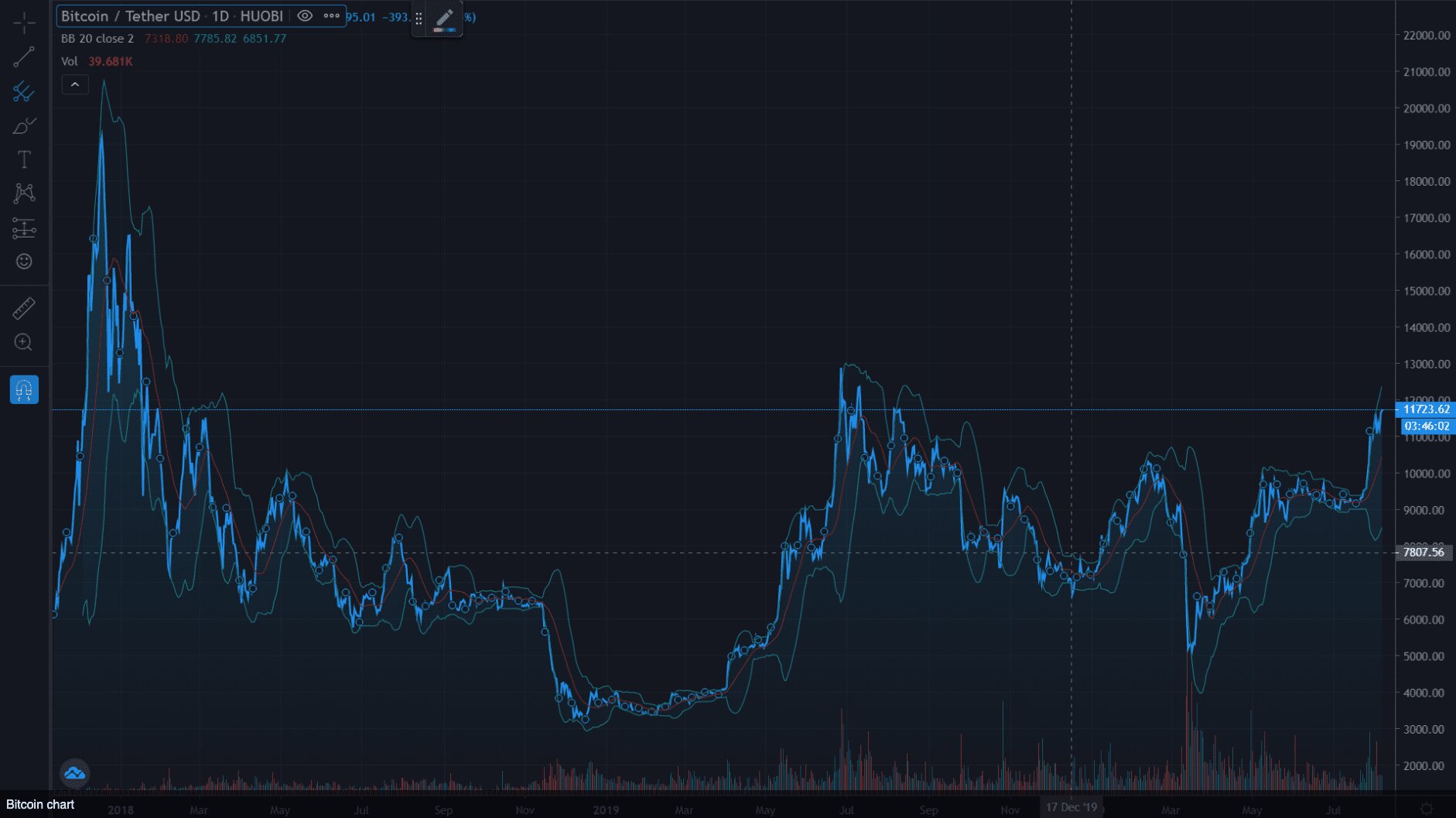Introduction
Welcome to the exciting world of cryptocurrency trading! With the rise in popularity and acceptance of digital currencies like Bitcoin, Ethereum, and Ripple, more and more people are exploring opportunities to buy and sell crypto for profit. However, with the volatile nature of the market, it is crucial to have a well-defined strategy and a thorough understanding of the factors that influence cryptocurrency prices.
Before diving into the world of crypto trading, it is important to note that the value of cryptocurrencies can fluctuate dramatically. Prices can soar to new heights one day and plummet the next. This volatility presents both opportunities and risks for traders and investors.
Whether you are considering short-term trading or long-term investing, it is vital to make informed decisions based on careful analysis of various factors. This article will guide you through the important considerations to keep in mind before buying and selling cryptocurrency, as well as provide insights into technical and fundamental analysis techniques, market conditions, setting entry and exit points, developing a trading strategy, and managing risks.
It is essential to note that the cryptocurrency market operates 24/7, unlike traditional stock markets. This non-stop trading environment can be both exciting and overwhelming for traders. However, with the right approach, you can navigate the crypto market with confidence and potentially generate substantial profits.
By combining technical analysis indicators, fundamental analysis, awareness of market conditions and trends, and applying effective risk management techniques, you can make more informed decisions and increase your chances of success in the cryptocurrency trading arena.
It is important to remember that no investment strategy is foolproof, and there are always risks involved. Therefore, emotional discipline also plays a vital role in maintaining a balanced and rational mindset throughout your trading journey. By staying emotionally disciplined, you can avoid impulsive decisions and stick to your trading plan.
Now, let’s delve deeper into the factors to consider before buying and selling cryptocurrency, starting with technical analysis indicators.
Factors to Consider Before Buying and Selling Crypto
Before entering the world of crypto trading, it is important to assess several key factors that can significantly impact your decision-making process. By carefully considering these factors, you can make informed choices and increase your chances of success in the cryptocurrency market.
1. Market Volatility: Cryptocurrencies are known for their high volatility. Prices can experience rapid fluctuations, which can provide opportunities for profit, but also increase the risk of losses. Before buying or selling crypto, consider whether you are comfortable with the level of volatility and are prepared to handle potential price swings.
2. Financial Goals: Clearly define your financial goals before entering the market. Determine whether you are looking for short-term gains or long-term investments. This will help you decide on the appropriate strategies and timeframes for buying and selling.
3. Risk Tolerance: Assess your risk tolerance level. Consider how much money you are willing to invest and potentially lose. Crypto trading involves risks, and it is crucial to only invest funds that you can afford to lose without negatively impacting your financial stability.
4. Knowledge and Research: Stay informed about the crypto market. Research and understand the cryptocurrencies you are interested in, their underlying technology, and the factors that can impact their value. Develop a solid understanding of the industry, news, and upcoming developments that could affect the market.
5. Regulatory Environment: Be aware of the regulatory environment surrounding cryptocurrencies. Different countries have varying regulations, which can impact the market and the legality of certain cryptocurrencies. Stay updated with the latest developments in regulations to ensure compliance and mitigate legal risks.
6. Security Measures: Cryptocurrency transactions involve digital assets, which can be vulnerable to cyber attacks or hacking attempts. Learn about the security measures employed by cryptocurrency exchanges and wallet providers. Take necessary precautions, such as using secure exchanges and implementing two-factor authentication, to protect your investments.
7. Liquidity: Consider the liquidity of the cryptocurrency you are interested in buying or selling. High liquidity ensures that you can enter and exit positions quickly and at a fair price. Low liquidity may make it harder to buy or sell large amounts without significantly impacting the market price.
8. Peer Evaluation and Professional Advice: Seek guidance from experienced traders and professionals in the crypto community. Engage in discussions, read forums, and follow reputable sources for insights and analysis. However, always conduct your own due diligence and do not solely rely on others’ opinions.
By carefully considering these factors, you can develop a clearer understanding of your risk appetite, investment goals, and the necessary steps to take before buying and selling cryptocurrencies. With a solid foundation of knowledge and a well-thought-out plan, you are on the right path to becoming a successful crypto trader or investor.
Technical Analysis Indicators to Watch
Technical analysis is a key component of cryptocurrency trading as it involves analyzing historical price data and patterns to predict future price movements. By studying charts and utilizing various technical indicators, traders can identify potential entry and exit points for buying and selling crypto. Here are some essential technical analysis indicators to keep an eye on:
1. Moving Averages (MA): Moving averages help smooth out price fluctuations and identify trends. The two common types of moving averages are the simple moving average (SMA) and the exponential moving average (EMA). Moving average crossovers, where short-term moving averages cross above or below long-term moving averages, can signal potential buying or selling opportunities.
2. Relative Strength Index (RSI): RSI measures the speed and change of price movements. It indicates whether a cryptocurrency is overbought or oversold. An RSI reading above 70 suggests overbought conditions and a possible sell signal, while an RSI reading below 30 suggests oversold conditions and a potential buy signal.
3. Bollinger Bands: Bollinger Bands consist of a simple moving average with upper and lower bands. These bands represent the volatility of the cryptocurrency’s price. When the price moves closer to the upper band, it indicates overbought conditions, and when the price approaches the lower band, it suggests oversold conditions. Traders can consider selling when the price is near the upper band and buying when the price is close to the lower band.
4. MACD Indicator: The Moving Average Convergence Divergence (MACD) is used to identify potential trend reversals. It consists of two lines – the MACD line and the signal line. When the MACD line crosses above the signal line, it is seen as a bullish signal, suggesting a potential buying opportunity. Conversely, when the MACD line crosses below the signal line, it indicates a bearish signal, implying a possible selling opportunity.
5. Fibonacci Retracement: Fibonacci retracement is a tool used to identify potential support and resistance levels. Traders use Fibonacci ratios (38.2%, 50%, and 61.8%) to determine areas where price corrections or reversals are likely to occur. This can help determine entry points for buying or selling crypto.
6. Volume: Volume is an essential indicator as it provides insights into the strength of a price movement. Higher trading volumes during an upward trend can suggest a continuation of the trend, while high volumes during a downward trend may indicate a potential trend reversal.
7. Candlestick Patterns: Candlestick patterns provide visual representations of price movements. Patterns such as doji, hammer, engulfing, and harami can indicate potential reversals or continuation of trends. Traders analyze these patterns in conjunction with other indicators to make informed trading decisions.
It is important to note that no single technical indicator can provide accurate predictions all the time. It is recommended to use a combination of indicators alongside other analysis techniques to gain more comprehensive insights and increase the probability of successful trades.
By monitoring these technical analysis indicators, traders can enhance their decision-making process and identify potential entry and exit points for buying and selling cryptocurrency. However, it is crucial to combine technical analysis with fundamental analysis and consider other market factors for a well-rounded trading strategy.
Fundamental Analysis Factors to Consider
Fundamental analysis is an important aspect of cryptocurrency trading as it involves evaluating the underlying factors that can influence the value and long-term prospects of a cryptocurrency. By assessing these fundamental factors, traders can make more informed decisions about buying and selling crypto. Here are some key fundamental analysis factors to consider:
1. Development Team and Leadership: Evaluate the development team and leadership behind the cryptocurrency project. Look for experienced and reputable individuals who have a track record of success in the industry. A strong team can contribute to the development and adoption of the cryptocurrency, which can positively impact its value.
2. Technology and Innovation: Assess the technology and innovation behind the cryptocurrency. Look for unique features, scalability, security, and interoperability. A cryptocurrency with advanced technology and innovative solutions may have a higher chance of long-term success and adoption.
3. Use Case and Market Adoption: Consider the real-world use case and market adoption of the cryptocurrency. Evaluate whether the cryptocurrency offers a solution to a current problem or has the potential to disrupt an existing industry. Higher adoption and usage can contribute to increased value over time.
4. Partnerships and Collaborations: Look for partnerships and collaborations that the cryptocurrency project has established. Strategic partnerships with established companies or organizations can enhance the credibility and visibility of the cryptocurrency. Partnership announcements can often result in price movements, so it’s important to stay updated with such developments.
5. Community and Social Media Presence: Assess the strength of the cryptocurrency’s community and its social media presence. A vibrant and engaged community can contribute to increased adoption, market awareness, and overall growth. Pay attention to community activities, forums, social media discussions, and sentiment analysis.
6. Market Demand and Competition: Evaluate the market demand for the cryptocurrency and its competitiveness within the industry. Consider factors such as market cap, trading volume, liquidity, and the presence of similar cryptocurrencies. A cryptocurrency with strong demand and limited competition may have a higher chance of appreciation.
7. Regulatory Environment: Stay updated with the regulatory environment surrounding cryptocurrencies. Changes in regulations can have a significant impact on the market and influence the legality, adoption, and future prospects of a cryptocurrency. Consider the jurisdiction and regulatory stance of the cryptocurrency project.
8. Financial Performance and Revenue Model: Review the financial performance and revenue model of the cryptocurrency project, if applicable. Look for transparency in financial reporting and a sustainable revenue generation strategy. A cryptocurrency project with a solid financial foundation may have a higher chance of success.
Fundamental analysis provides a long-term perspective on the value and potential growth of a cryptocurrency. It complements technical analysis and helps traders make more well-rounded decisions. However, it is important to note that fundamental analysis requires ongoing research and staying updated with the latest developments in the cryptocurrency industry.
By considering these fundamental analysis factors, traders can gain a deeper understanding of the potential value and prospects of a cryptocurrency. This information can guide their buying and selling decisions and help them navigate the dynamic cryptocurrency market more effectively.
Market Conditions and Trends
When it comes to buying and selling cryptocurrency, understanding market conditions and trends is crucial. The cryptocurrency market is known for its volatility, and being aware of the overall market conditions can help traders make informed decisions. Here are some factors to consider when assessing market conditions and trends:
1. Market Sentiment: Market sentiment refers to the overall attitude and perception of traders and investors towards the cryptocurrency market. It can be influenced by various factors, including news events, regulatory changes, macroeconomic conditions, and investor sentiment. Positive market sentiment often results in upward price trends, while negative sentiment can lead to price declines.
2. Market Cycles: The cryptocurrency market operates in cycles, characterized by periods of bullishness and bearishness. Understanding these cycles can help traders identify potential entry and exit points. Market cycles are influenced by factors such as investor behavior, adoption rates, regulatory changes, and macroeconomic trends.
3. Seasonality: Like traditional financial markets, the cryptocurrency market exhibits seasonality patterns. Historical data has shown that certain periods, such as the end of the year or tax season, tend to have increased trading activities or market movements. Traders can take advantage of these seasonal trends by adjusting their strategies accordingly.
4. Technical Analysis Patterns: Analyzing chart patterns and technical indicators can help identify market trends and potential price reversals. Patterns such as uptrends, downtrends, triangles, and double tops or bottoms can provide insights into the overall market direction. Traders can use these patterns in combination with other analysis techniques to make informed trading decisions.
5. Market Volume and Liquidity: Monitoring market volume and liquidity is important for assessing the strength and stability of a market trend. Higher trading volume and liquidity can indicate strong involvement from traders and investors, providing more validity to the trend. Conversely, low volume and liquidity may suggest a lack of market participation and potentially unpredictable price movements.
6. News and Events: Stay updated with the latest news and events in the cryptocurrency industry. News related to regulations, partnerships, technological advancements, security breaches, or market announcements can significantly impact market conditions and trigger price movements. Traders should be prepared to react to such news and events accordingly.
7. Crypto Market Capitalization and Dominance: Monitor the overall market capitalization of the cryptocurrency market and the dominance of specific cryptocurrencies like Bitcoin or Ethereum. Changes in market capitalization and dominance can indicate shifts in investor preferences and market trends.
8. Social Media and Influencer Trends: Analyze social media platforms and follow influential figures in the cryptocurrency space. Social media sentiment and trends can provide insights into market expectations, potential investment opportunities, and emerging trends.
Combining these factors and staying aware of changes in market conditions and trends can help traders make more informed decisions. It is important to conduct thorough research, use a variety of analysis techniques, and adapt trading strategies accordingly to navigate the dynamic and ever-changing cryptocurrency market.
Setting Entry and Exit Points
Setting entry and exit points is a critical aspect of successful cryptocurrency trading. By establishing clear entry and exit points, traders can minimize risks and maximize potential profits. Here are some key considerations when setting entry and exit points:
1. Technical Analysis: Utilize technical analysis indicators and chart patterns to identify potential entry and exit points. Look for indicators such as support and resistance levels, trend lines, and breakouts. These can provide insights into optimal entry points for buying and exit points for selling.
2. Risk-Reward Ratio: Determine your desired risk-reward ratio for each trade. This ratio represents the potential profit compared to the potential loss. It is important to set a ratio that aligns with your risk tolerance and trading strategy. Consider a risk-reward ratio of at least 1:2, meaning that your potential profit is at least double your potential loss.
3. Stop Losses: Implement stop losses to protect against significant losses. A stop loss is a predetermined price at which you would sell your cryptocurrency to limit potential losses. Set your stop loss based on the level of risk you are willing to tolerate for each trade. This ensures that you exit a trade if the price moves against your position beyond a certain point.
4. Take Profits: Determine your profit-taking strategy. Set a target price at which you would sell to secure your profits. This target can be based on technical analysis indicators, key price levels, or your own trading goals. Taking profits at predetermined levels can help you lock in gains and avoid potential market reversals.
5. Trailing Stops: Consider using trailing stops to protect profits and let your winning trades run. A trailing stop is an adjustable stop loss that moves with the price as it moves in your favor. It allows you to capture more gains if the price continues to rise, while also protecting against sudden reversals by locking in profits as the price retraces.
6. Market Conditions: Take into account the current market conditions and volatility when setting entry and exit points. In high-volatility markets, consider wider stop loss and target levels to account for price fluctuations. In low-volatility markets, narrower levels may be appropriate to optimize risk-reward ratios.
7. Timeframes: Consider the timeframe of your trades when setting entry and exit points. Short-term traders may focus on intra-day or daily charts for precise entry and exit points, while long-term investors may base their decisions on higher timeframes. Align your entry and exit points with the timeframe that suits your trading strategy.
8. Flexibility and Adaptability: Remain flexible and adaptable in your approach to setting entry and exit points. Market conditions can rapidly change, and it is essential to adjust your strategy accordingly. Regularly monitor the market, reevaluate your positions, and be prepared to revise your entry and exit points as needed.
Setting entry and exit points requires a combination of technical analysis, risk management, and awareness of market conditions. It is important to plan your trades in advance, consider your risk tolerance, and stick to your trading strategy. Remember that no strategy is foolproof, and continuous learning and adjustment are key to improving your trading skills over time.
Developing a Trading Strategy
Developing a solid trading strategy is vital for success in the cryptocurrency market. A well-defined strategy helps traders make informed decisions, manage risks, and increase their chances of profitability. Here are some key steps to consider when developing a trading strategy:
1. Set Clear Goals: Define your trading goals, whether they are focused on short-term gains or long-term investments. Establish specific and realistic targets for profit, risk tolerance, and desired returns. Clear goals provide a framework for your trading strategy and help you stay focused.
2. Determine Your Trading Style: Identify your preferred trading style, whether it’s day trading, swing trading, or long-term investing. Each style requires different timeframes, risk management techniques, and analysis approaches. Choose a strategy that aligns with your risk tolerance, time availability, and personal preferences.
3. Choose Your Analysis Methods: Select the analysis methods you will use to make trading decisions. Consider utilizing a mix of technical analysis, fundamental analysis, and market sentiment analysis. Experiment with different indicators, chart patterns, and tools to find what works best for your trading strategy.
4. Set Entry and Exit Criteria: Determine the criteria for entering and exiting trades. Set clear rules based on technical indicators, price levels, or a combination of factors. Establish specific entry points, stop loss levels, and profit targets. This ensures that you have a structured approach and minimize emotional decision-making.
5. Risk Management: Develop a strong risk management strategy. Determine your risk-reward ratio, position size, and allocation of funds for each trade. Implement stops losses and take profit levels to protect your capital and manage potential losses. Adhering to strict risk management practices is essential for long-term success.
6. Backtesting and Paper Trading: Test your trading strategy by backtesting it using historical data. Analyze how your strategy would have performed in different market conditions. Additionally, consider practicing in a simulated trading environment or using paper trading accounts to validate the effectiveness of your strategy before risking real capital.
7. Regular Analysis and Evaluation: Continuously analyze, evaluate, and adjust your trading strategy. Regularly review your trades, identify strengths and weaknesses, and make necessary modifications. Stay updated with market trends, news, and developments to adapt your strategy accordingly.
8. Emotional Discipline: Develop emotional discipline and stick to your trading strategy. Avoid making impulsive decisions based on fear or greed. Emotions can cloud judgment and lead to poor trading outcomes. Stay disciplined, follow your predetermined rules, and be patient in waiting for optimal trading opportunities.
Remember, a trading strategy is not set in stone and should evolve as you gain experience and learn from market dynamics. Continually educate yourself, adapt to changing market conditions, and remain open to refining your strategy. By doing so, you can improve your trading skills and increase your chances of success in the cryptocurrency market.
Strategies for Short-Term Trading
Short-term trading in the cryptocurrency market involves taking advantage of price fluctuations over a relatively brief time period, ranging from minutes to days. To succeed in short-term trading, traders often employ specific strategies tailored to capture quick profits. Here are some popular strategies for short-term trading:
1. Scalping: Scalping is a strategy that involves making multiple trades throughout the day to capture small price movements. Traders aim to profit from short-term volatility by entering and exiting positions quickly. Scalpers often focus on highly liquid cryptocurrencies with tight bid-ask spreads.
2. Trend Trading: Trend trading involves identifying and following the prevailing market trends. Traders look for upward or downward trends and enter positions that align with the trend direction. They aim to ride the trend and exit the position before the trend reverses. Technical analysis tools, such as moving averages and trend lines, can assist in identifying and confirming trends.
3. Breakout Trading: Breakout trading focuses on identifying potential price breakouts from established support or resistance levels. Traders aim to enter positions as the price breaks out from these levels, anticipating a significant price movement in the breakout direction. Volume analysis and chart patterns, such as triangles or rectangles, can aid in identifying potential breakouts.
4. Range Trading: Range trading is employed when a cryptocurrency moves within a specific price range, oscillating between support and resistance levels. Traders aim to buy at support and sell at resistance, profiting from price bounces as the cryptocurrency moves within the range. Traders may use oscillators, such as the Relative Strength Index (RSI), to confirm overbought or oversold conditions within the range.
5. News Trading: News trading involves capitalizing on significant news events that can cause substantial price movements. Traders closely monitor news releases, such as regulatory announcements or partnerships, and position themselves to take advantage of the resulting price volatility. Quick and decisive actions are crucial when employing this strategy as news-driven price movements can be short-lived.
6. Arbitrage: Arbitrage is a strategy that exploits price differences among different cryptocurrency exchanges. Traders simultaneously buy a cryptocurrency at a lower price on one exchange and sell it at a higher price on another exchange to profit from the price discrepancy. This strategy requires fast execution and a deep understanding of exchange order books and fees.
7. Automated Trading: Automated trading involves using algorithms or bots to execute trades based on predefined rules. These programs can analyze market data, identify trading opportunities, and execute trades without human intervention. Automated trading can help capture short-term price movements and react quickly to market changes.
For successful short-term trading, it is essential to diligently monitor the market, apply proper risk management techniques, and adapt to evolving market conditions. Traders should also be aware of potential risks and limitations associated with short-term trading, including higher transaction costs, increased exposure to market volatility, and the need for fast decision-making.
Before employing any short-term trading strategy, it is recommended to thoroughly backtest and practice in simulated trading environments to gain familiarity and fine-tune your approach. Continuous learning, discipline, and the ability to manage emotions are vital traits for short-term traders in the dynamic cryptocurrency market.
Strategies for Long-Term Investing
Long-term investing in the cryptocurrency market involves holding onto assets for an extended period, typically months to years, with the expectation of substantial appreciation over time. Long-term investors focus on the fundamental value and potential growth of cryptocurrencies. Here are some strategies commonly used for long-term investing:
1. Dollar-Cost Averaging (DCA): DCA involves investing a fixed amount of money at regular intervals, regardless of the current price of a cryptocurrency. By consistently purchasing at predetermined intervals, long-term investors can mitigate the impact of short-term price volatility and take advantage of potential downward price fluctuations.
2. Research and Fundamental Analysis: Long-term investors conduct extensive research and perform fundamental analysis to identify cryptocurrencies with strong potential for long-term growth. They assess factors such as technological innovation, adoption rates, development team, partnerships, and the overall use case and market demand of the cryptocurrency.
3. Buy and Hold: The buy and hold strategy entails purchasing a cryptocurrency and holding onto it for an extended period, regardless of short-term fluctuations. Long-term investors believe in the long-term value and growth potential of the cryptocurrency and aim to capitalize on the appreciation over time.
4. Diversification: Long-term investors often diversify their portfolios by investing in a variety of cryptocurrencies. By spreading investments across different cryptocurrencies, industries, and market segments, investors can reduce the risk associated with individual cryptocurrencies and increase the potential for overall portfolio growth.
5. HODL Strategy: HODL, a term derived from a misspelling of “hold,” refers to a strategy where investors hold onto their cryptocurrencies regardless of short-term price movements. Long-term investors believe that the cryptocurrency market will continue to grow over time and that holding onto their investments will result in substantial returns in the long run.
6. Regular Evaluation and Monitoring: Long-term investors regularly evaluate and monitor their investment portfolio. They stay updated with market trends, technology advancements, and news related to their investments. Periodic assessments allow investors to make informed decisions about whether to continue holding or rebalance their portfolios based on changing market conditions.
7. Patience and Discipline: Long-term investing requires patience and discipline. Cryptocurrency markets can be volatile, and prices can experience significant fluctuations. Long-term investors are prepared to weather short-term price declines and remain focused on their investment goals, trusting in the long-term value proposition of their chosen cryptocurrencies.
Long-term investing is not without risks, and market uncertainties can impact the performance of investments. It is important for long-term investors to stay informed, adapt to evolving market conditions, and periodically reassess their investment strategies as needed.
Remember, long-term investing requires a long-term perspective. It is crucial to set realistic expectations and understand that cryptocurrency investments can take time to yield substantial returns. By employing a well-researched and disciplined long-term investment strategy, investors can aim to capture long-term market growth and potentially realize significant profits.
Risk Management Techniques
Risk management is a crucial aspect of cryptocurrency trading and investing. Effectively managing risk can help protect capital, minimize potential losses, and increase the probability of long-term success. Here are some essential risk management techniques to consider:
1. Determine Risk Tolerance: Assess your risk tolerance level before entering the cryptocurrency market. Understand how much capital you are comfortable putting at risk and the potential impact of losses on your overall financial situation. This self-assessment will help you establish appropriate risk management strategies.
2. Position Sizing: Determine the size of each position based on your risk tolerance. Ensure that the amount allocated to any single trade is within your acceptable risk limits. Many traders recommend risking no more than 1-2% of your total trading capital on any given trade to limit potential losses.
3. Stop Loss Orders: Implement stop loss orders to protect against significant losses. A stop loss is a predetermined price at which you will automatically sell your cryptocurrency. It acts as a safety net, closing out a trade if the price moves against your position beyond a certain point. Set stop loss levels based on technical analysis, support and resistance levels, or your risk tolerance.
4. Take Profit Targets: Set take profit targets to secure profits before the market reverses. These targets represent prices at which you will sell your cryptocurrency to lock in gains. Establishing profit targets helps you define exit points and avoid potential market reversals that could erode your profits.
5. Diversification: Diversify your portfolio to mitigate risk. Invest in a range of different cryptocurrencies and spread your investments across various sectors or industries. By diversifying, you reduce the impact of any single investment on your overall portfolio and decrease the risk associated with individual cryptocurrencies.
6. Risk-Reward Ratio: Consider the risk-reward ratio for each trade. Assess the potential profit compared to the potential loss before entering a trade. A favorable risk-reward ratio ensures that potential profits outweigh potential losses, improving the overall profitability of your trading strategy.
7. Regular Evaluation: Regularly evaluate your trades and overall portfolio to determine if adjustments are needed. Assess the performance of your investments, review your risk management techniques, and identify areas for improvement. Regular evaluations help you refine your strategy and respond to changing market conditions.
8. Continuous Learning and Research: Stay informed and continuously educate yourself about the cryptocurrency market. Keep up-to-date with industry news, technological advancements, and regulatory changes that may impact your investments. Enhancing your knowledge will enable you to make more informed decisions and adapt your risk management strategies accordingly.
It is important to note that risk management does not eliminate all risks, but rather aims to minimize potential losses. It is crucial to monitor market conditions and adjust your risk management techniques as needed. Remember to stay disciplined and stick to your risk management plan, even during periods of market volatility or emotional decision-making.
By implementing these risk management techniques, you can help protect your capital and increase your resilience in the face of market uncertainties. Managing risk effectively is key to long-term success and sustainability in the ever-changing cryptocurrency market.
Emotional Discipline in Trading
Emotional discipline is a critical aspect of successful cryptocurrency trading. The highly volatile and unpredictable nature of the cryptocurrency market can evoke strong emotions, which can negatively impact decision-making and overall performance. Developing emotional discipline is key to making rational trading decisions and maintaining a balanced mindset. Here are important practices to cultivate emotional discipline:
1. Recognize and Control Emotions: Recognize that emotions, such as fear, greed, and impatience, can influence your decision-making process. Acknowledge these emotions when they arise and strive to control them. Emotions can lead to impulsive actions that may deviate from your trading strategy.
2. Stick to Your Trading Strategy: Create a well-defined trading strategy and adhere to it. Having a clear plan helps you avoid emotional and irrational decisions. Follow your predetermined entry and exit points, risk management rules, and profit targets. Consistency in executing your strategy helps mitigate emotional responses to market fluctuations.
3. Manage Expectations: Set realistic expectations for your trading journey. Cryptocurrency trading involves risks, and losses are inevitable at times. Understand that losses are part of the learning process and are to be expected. Avoid becoming overly emotional or disheartened by temporary setbacks.
4. Practice Patience: Patience is an essential virtue in cryptocurrency trading. Avoid the temptation to act on impulse or chase quick profits. Wait for optimal trading opportunities that align with your strategy and analysis. Patience allows you to make more rational decisions based on sound reasoning rather than emotional impulses.
5. Conduct Regular Self-Assessment: Conduct periodic self-assessments to evaluate your emotional state and trading performance. Reflect on any emotional biases or patterns that may be affecting your decision-making. Identifying and acknowledging emotional weaknesses empowers you to work on improving them over time.
6. Take Breaks and Practice Self-Care: Take regular breaks from trading to recharge and maintain a clear mindset. Staring at price charts for an extended period can lead to exhaustion and clouded judgment. Engage in activities outside of trading and prioritize self-care to reduce stress and improve emotional well-being.
7. Learn from Mistakes: Embrace and learn from your trading mistakes. Avoid dwelling on past losses or letting emotions guide your future decisions. Analyze your trades objectively, identify areas for improvement, and adjust your strategy accordingly. Learning from mistakes helps you grow as a trader and develop stronger emotional discipline.
8. Seek Support and Education: Surround yourself with a supportive community of fellow traders or seek guidance from experienced professionals. Engage in discussions, share experiences, and learn from others’ insights. Continuous education, attending workshops, and learning from reputable sources can also enhance your emotional discipline.
Remember, emotional discipline takes time to develop and is an ongoing process. Stay committed, be patient with yourself, and remain disciplined even during periods of market volatility. Maintaining emotional discipline allows you to make well-informed decisions based on analysis and strategy rather than impulsive reactions driven by emotions.
By cultivating emotional discipline, you can navigate the challenges of the cryptocurrency market with confidence and resilience. It is the key to maintaining a balanced mindset and increasing your chances of long-term success as a cryptocurrency trader.
Conclusion
Cryptocurrency trading offers exciting opportunities for both short-term traders and long-term investors. However, navigating the unpredictable and volatile nature of the cryptocurrency market requires knowledge, strategy, and emotional discipline. By considering the factors discussed in this article, traders can make more informed decisions and increase their chances of success.
Before buying and selling cryptocurrencies, it is crucial to evaluate market conditions, conduct technical and fundamental analysis, and understand the risks associated with trading. Developing a well-defined trading strategy, whether for short-term trading or long-term investing, helps establish clear entry and exit points, manage risk, and achieve financial goals.
Technical analysis indicators and chart patterns assist in identifying potential market trends and entry/exit points, while fundamental analysis focuses on evaluating the underlying value and growth potential of cryptocurrencies. Being aware of market conditions, liquidity, and the regulatory environment is essential for making informed trading decisions.
Risk management techniques, such as determining risk tolerance, implementing stop losses and take profits, diversifying portfolios, and employing proper position sizing, help protect capital and minimize potential losses. Additionally, developing emotional discipline is crucial for maintaining a balanced mindset, making rational decisions, and mitigating the influence of emotions on trading performance.
It is important to note that the cryptocurrency market is highly dynamic and constantly evolving. Continuous learning, staying updated with the latest market trends and developments, and adapting strategies accordingly are essential for long-term success as a cryptocurrency trader or investor.
By combining technical and fundamental analysis, implementing effective risk management strategies, and fostering emotional discipline, traders can navigate the cryptocurrency market with confidence, increase their chances of profitability, and achieve their financial goals in this exciting and ever-changing industry.

























